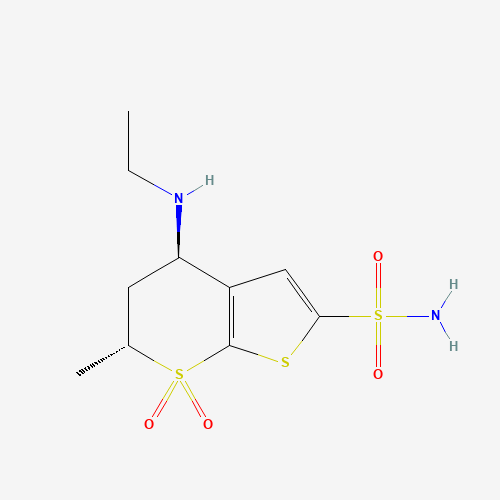| Pharmaceutical Information |
| Drug Name |
4r,6r-dorzolamide |
| Drug ID |
BADD_D00006 |
| Description |
Dorzolamide is a non-bacteriostatic sulfonamide derivative [A1304] and topical carbonic anhydrase (CA) inhibitor that treats elevated intraocular pressure (IOP) associated with open-angle glaucoma and ocular hypertension.[L11377] It works by blocking an enzyme in the ciliary process that regulates ion balance and fluid pressure in the eyes.[A1303] Unlike oral CA inhibitors, dorzolamide has negligible effects of acid-base or electrolyte disturbances and other systemic adverse effects.[A1304] First marketed in 1995,[A190624] dorzolamide is available in ophthalmic solutions as monotherapy marketed as Trusopt [L11377] or in combination with [timolol] as Cosopt PF.[L11380] |
| Indications and Usage |
Dorzolamide is indicated for the management of elevated intraocular pressure in patients with ocular hypertension or open-angle glaucoma.[L11377] It can also be used in combination with [timolol] for the same indication in patients who are insufficiently responsive to ophthalmic beta-blockers.[L11380]
Its pre-operative use was also investigated to prevent elevated intraocular pressure after neodynium yttrium aluminum garnet laser posterior capsulotomy.[A190183] |
| Marketing Status |
approved |
| ATC Code |
S01EC03 |
| DrugBank ID |
DB00869
|
| KEGG ID |
D07871; D00653
|
| MeSH ID |
C062765
|
| PubChem ID |
92087
|
| TTD Drug ID |
D05UYW
|
| NDC Product Code |
70377-081; 14445-404 |
| UNII |
55O5C6I73D
|
| Synonyms |
dorzolamide | 4-ethylamino-5,6-dihydro-6-methyl-7,7-dioxide-4H-thieno(2,3-b)thiopyran-2-sulfonamide | 5,6-dihydro-4-ethylamino-6-methyl-4H-thieno(2,3-b)thiopyran-2-sulfonamide-7,7-dioxide | dorzolamide, (trans)-isomer | Dorzolamide Chibret | MK 507 | MK-507 | Trusopt | dorzolamide hydrochloride | L 671152 | L-671,152 |
|
| Chemical Information |
| Molecular Formula |
C10H16N2O4S3 |
| CAS Registry Number |
120279-89-2 |
| SMILES |
CCNC1CC(S(=O)(=O)C2=C1C=C(S2)S(=O)(=O)N)C |
| Chemical Structure |

|
|
| ADRs Induced by Drug |
|
|
*The priority for ADR severity classification is based on FAERS assessment, followed by the most severe level in CTCAE rating. If neither is available, it will be displayed as 'Not available'.
**The 'Not Available' level is hidden by default and can be restored by clicking on the legend twice..
|
|
|

